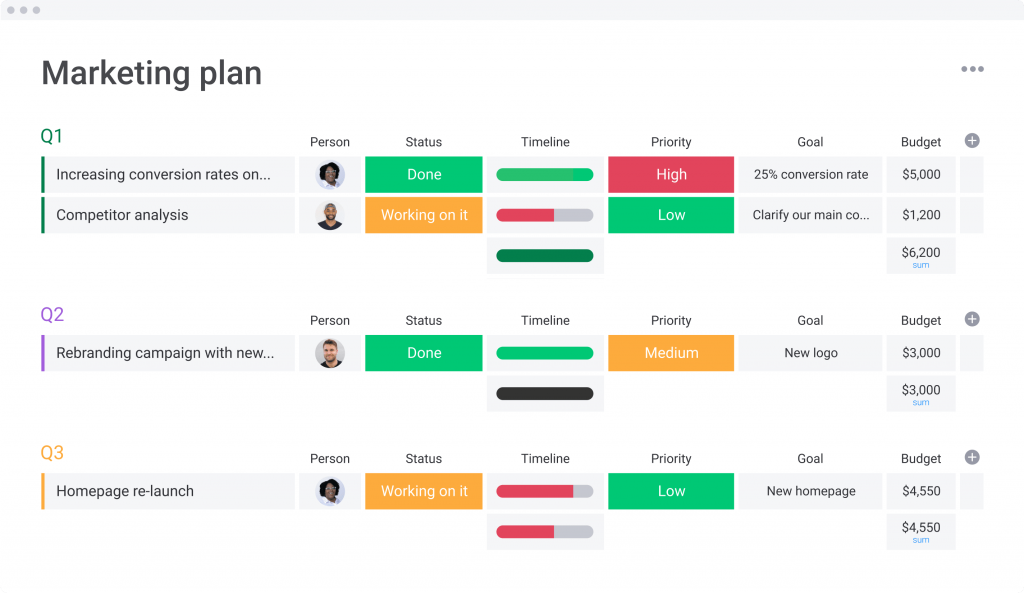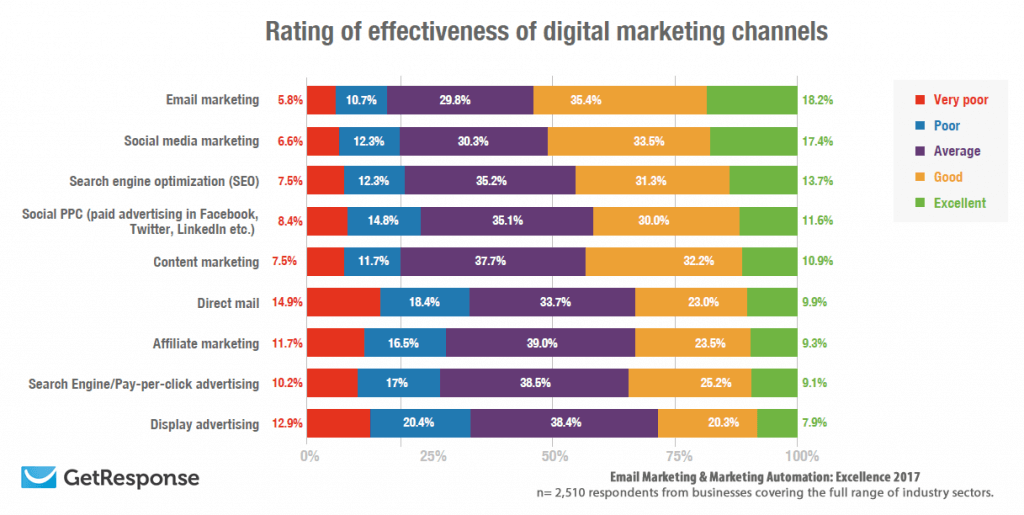
As businesses increasingly move online, digital marketing strategy is an indispensable part of a modern business model. Creating a digital marketing plan is the best way to manage your resources and ensure your marketing efforts are accomplishing your goals.
What is a Digital Marketing Plan?
A digital marketing plan is a document that outlines a company’s marketing goals and determines steps and timelines for achieving them.
When planning the company’s digital marketing strategy, each action taken should correspond to the planning document to ensure it aligns with the business’s goals.

Image source: Monday
How Can a Digital Marketing Plan Set You Up for Success?
Any digital marketing strategy benefits from organization and forethought. However, research indicates that only about 37% of B2B marketers are documenting their strategies and methods. This means that even if their marketing efforts are demonstrating results, it will be difficult to report or repeat the success.
That’s why a digital marketing plan is so important. It creates a guiding document that can be used to measure your business’s marketing campaigns and ensure that your entire team stays on track.
In addition to giving your company a goal to measure itself against, a digital marketing plan also helps your marketing team become more productive. A detailed digital marketing strategy framework contains concrete milestones assigned to specific team members to ensure each part of the plan is implemented on time.
A Step-to-Step Guide to Creating a Digital Marketing Plan
Many businesses are allocating budget spend to digital marketing tools and seeing modest results. Investing in a PPC campaign, for example, will most likely demonstrate some success.
Aligning your digital marketing tools with an overall plan allows you to maximize your budget and get the maximum results from your marketing investments.
Get The Whole Team Involved
Different portions of the marketing team can sometimes exist as separate entities within an organization, siloed off from other groups. This damages communication, wastes resources, and sometimes results in groups working at cross-purposes.
Your social media team might have great plans for expanding into TikTok, but how does that align with your content marketers’ goals of generating more inbound traffic? Which goal should receive more budget spend?
Your digital marketing plan should be a document that guides the efforts of all segments of your marketing team. Include everyone in its creation.
Set Specific Goals
Every business wants more traffic and more sales. That’s why it’s so easy to chase new marketing tools - they promise to deliver both of these things if you simply implement a new tool or strategy.
When weighing the myriad of digital marketing strategies and tools there are to choose from, it’s best to have highly specific goals that are tied to a specific timeframe. This keeps them measurable and accomplishable.
Setting a goal of “driving more PPC traffic” is too vague. A goal like “achieve a 5% conversion rate on PPC campaigns over the next 9 months” is better. It includes specific benchmarks to meet and a timeframe in which to meet them. This in turn will help you choose the best possible strategies to help you meet that specific goal.
Use Previous Data
If you’ve been running marketing campaigns for a time, then you should already have baseline data. This is helpful because it allows you to work with some idea of the ROI you should be expecting from a particular campaign.
If your business wants to boost its social marketing strategy, and you’re already receiving 2,000 impressions per month from Facebook ads, then that becomes your baseline. When writing your digital marketing plan, you might decide that you want to achieve 3,000 impressions. Or perhaps you’re happy with the 2,000 impressions per month, but want to achieve that with a slightly lower budget. There are many ways to fine-tune your approach when working within a larger plan.
Conduct Competitor Research
Even if you don’t have in-house KPIs to analyze for your marketing plan, you can still analyze your competitors to see which strategies they are using.
Some marketers recommend completing the competitor research stage of their marketing plan as part of a larger SWOT analysis. SWOT stands for Strengths, Weaknesses, Opportunities, and Threats, and it’s one way to analyze your business in the context of its competition.

Image source: Wordstream
For example, you might look at your competitors’ unique selling propositions. If your rivals are focused on pushing the affordability of their services, might there be an opportunity to position yourself as a premium option?
In terms of marketing channels and strategies, it’s a good idea to see where your competitors are advertising. Often, you can capitalize on the prior market research of your competitors and take a page out of their digital marketing plan template. If everyone is advertising on LinkedIn, there’s a good chance that’s where your target audience is most active online.
Customer Research
Analyzing your competitors and analyzing your customers go hand-in-hand. They are both parts of the same project - to determine what problems consumers are trying to solve and identify ways that your business can do it better than your competitors.
Customer research should be part of your digital marketing strategy framework because it maintains the marketing focus on the needs of the customer, not the needs of the business. While you should certainly be focusing on traffic and sales, it’s important to keep in mind that you are offering services to customers.
It doesn’t require hiring an expensive market research firm to find out what customers are looking for. If you have an existing customer base, you can incentivize them to share information with you by offering entries in a giveaway or coupons for filling out a survey.
There are a myriad of digital tools for eCommerce businesses aimed at making customer research easier for your digital marketing strategy.
Tools like Google Analytics can give you a bird’s-eye view of customer search patterns and behavior, while sites like QuestBack quickly conduct customer research for you.

Key Components of a Modern Digital Marketing Plan
It’s easier to create a comprehensive digital marketing strategy when you break it down into smaller components.
While there are multiple ways to structure a digital marketing plan, it is best to keep the flow logical, starting with goals and breaking it down into specific steps to achieve them. We’ll cover the key components that you should include in your digital marketing strategy document.
Summary
This section is simply a condensed version of your overall digital marketing plan. This makes it easier to define and communicate the most important features of your plan to others in your business.
When getting other team members on board with the new plan, it can be easy to get lost in the weeds of the details. A clear, concise summary keeps the big picture in everyone’s mind and keeps details aligned with the overall goal.
Marketing Objectives
This section is where you lay out your goals. It is often a good idea to further break down this section into subcategories that make it easier to digest the information.
For example, some digital marketing plans separate their goals into large goals and specific milestones to get there. This keeps the ultimate objective in mind.
Whatever your specific marketing objectives, they should have three characteristics: specific, quantifiable, and come with a deadline.
A business might want to increase its monthly revenue by $10,000 and to do that they need 20 more subscriptions. They can set smaller goals like achieving 10 re-subscriptions and 10 new subscriptions, along with the marketing strategies they will use to achieve this.
Each objective should have a specific time frame attached. In the subscriptions example, the business may decide that 3 months is a reasonable period of time to achieve 20 more subscriptions.
Digital Marketing Channels
Once the goals are outlined, the digital marketing strategy needs to outline what avenues will be used to achieve these goals. There are many ways of generating inbound traffic, for example - the plan needs to explain specifically which ones will be used.
This is one of the most important sections of your digital marketing plan because it helps your team focus on the best avenues to achieve its goals and exclude other channels that are good, but not the best. This eliminates distraction and marketing FOMO.

Image source: GetResponse
Some digital marketing channels that can be included in your plan might be:
- YouTube
- Tiktok
- Email Marketing
- PPC
- SEO
Dabbling in a little bit of everything usually isn’t the best strategy - you want to make sure the channels you have up and running are meeting the goals and timelines outlined in your marketing plan before you implement something new.
Task Allocation
It’s great to have a comprehensive to-do list of all the marketing goals for the quarter, year, or even decade. But how do you determine who is going to make those goals a reality?
There is a place for this on your digital marketing plan. Go back to your list of marketing objectives. Take another look to make sure each goal really is broken down into as many specific steps as possible. If you want to expand your blog presence, exactly how many articles do you plan to post a month? That should be listed as its own goal.
Now, you can take each sub-goal and assign it to a specific person on your team, along with the deadline. Perhaps one person handles all the blogging for that portion of your strategy, or maybe different members of your team each write one a month. Clearly attach a name to each task, or assume it won’t get done at all.
Implement a CMS
A digital marketing strategy that clearly outlines all goals, timelines, and work assignments is a crucial guiding document. It can be a bit cumbersome for day-to-day use, however.
To make sure that the plan is reflected in everyone’s daily workload, a content management system (CMS) is a good idea if you don’t already have one. Make sure each of the specific tasks and deadlines is populated into the CMS, so you can make sure you’re on track to complete your goals.

Image source: Kinsta
Budget Strategy
Finally, your digital marketing strategy plan should include guidance for how these goals will be funded.
These numbers can be included as a percentage of the marketing budget or as absolute numbers. In some cases, the goal may be to maintain a comfortable level of results but see if costs can be reduced anywhere.
In other cases, the business may be willing to divert more resources to a new marketing strategy. A digital marketing plan is how your team can demonstrate that the money is being well-spent and producing ROI for the company.
Digital Marketing Plan Example
If you’re looking for a digital marketing plan sample to guide your team’s efforts, we’ve got you covered.
We’ve created a digital marketing plan template that you can use as a guide. This example is for a fictional company, ABC marketing, that wants to market its SEO consulting services.
Summary
ABC Marketing will implement a new digital marketing plan this quarter to increase monthly impressions, leads, and conversions through paid search, Facebook and Instagram marketing, and our blogging strategy. We will accomplish this through a consistent digital content creation strategy along with heavy budget reallocation toward paid search.
Marketing Objectives
- Increase new monthly leads from 25 to 45
- Increase monthly conversions from 15 to 25
- Increase monthly paid search impressions from 2,500 to 3,000
Digital Marketing Channels
- Email marketing
- Facebook & Instagram Marketing
- Paid Search
- Blogging
Task Allocation (this breakdown will vary depending on the size of your marketing team; for this example, the company has a small team)
- Kate will create and send 1 new nurture email sequence per month to all leads
- Mark will publish 2 blogs/month
- Jenna will manage monthly paid search campaigns and measure funnel conversion rates
- Dante will create and schedule 3 monthly Facebook posts and 4 monthly Instagram posts to increase CTR
Budget Strategy
- 60% of the budget to paid search
- 20% of the budget to Facebook and Instagram marketing
- 10% of the budget for email marketing
- 10% of the budget for blogging
What Can a Digital Marketing Plan Do for You?
Digital marketing strategies are only effective if they are intentional, consistent, and measurable. Backing up your digital marketing efforts with a solid body of research to back your goals will help you set attainable benchmarks and ultimately, grow your business.





